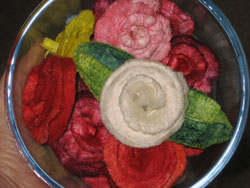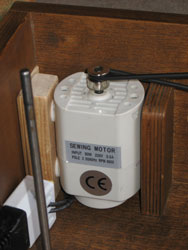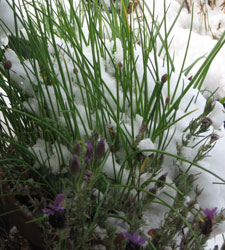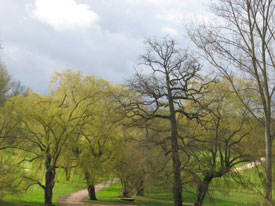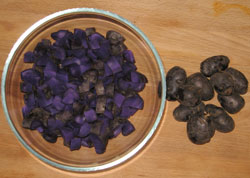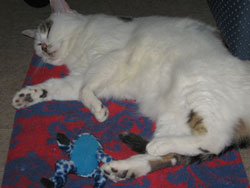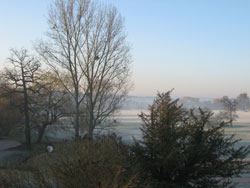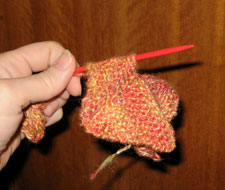The archives
Return to the
Now spinning
page
Explorations, winter into spring
January - May 2008
Today is my mother's birthday, so my thoughts turn to flowers.
My thoughts have been tending that way all week, actually. This bowl of roses is the result. They were all white at first -- which, of course, couldn't last here in the land of burbling dyepots. ;-) Some nice pinks and yellows are drying on the rack, even as I type.
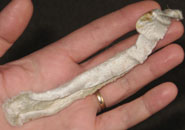
These roses are made of silk and had their origins as a baggie of unpromising, dull white silk waste rods (right). The rods come from the silk-reeling process: as the silk being reeled passes over tensioners and guide rods, it deposits "stuff" -- short bits of silk fibre and gummy sericin, mostly. When the coating of "stuff" on the rods starts interfering with the silk's progress, they cut the coating off by slitting it along one side -- and that's what these things are.
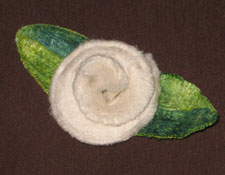
You can stretch them, dye them, turn them into beads.... They're weird little things, but they're fun to play with. And they're cheap. And they make lovely flowers!
I don't yet know what to do with these silk blossoms. With full-sized leaves (also made from silk rods), they're too wide for brooches -- but smaller leaves could turn that around completely.
And what else... a crystal dewdrop maybe? Stay tuned!
This is one of those spinning-related things that's more mechanical than fibery.
Remember my new/used electric spinner, and how it was not as fast as I'd wanted? Well, a new motor came home with me from England! I spent the dank, dark day after the brilliant snowy morning installing it.
The first worry resolved itself as soon as I got the thing out of its box: the new motor is exactly the same size as the old one. That meant I wouldn't have to do anything clever to make it fit the alotted space (whew!).
The second worry was how, exactly, the old motor was fastened in place -- and whether or not it could be gracefully un-mounted. ...It was held in its corner by a single bolt. Small foam pads on the bottom and sides of the motor kept it wedged in position and also (I imagine) dampened vibration.
A quick rummage unearthed a pack of sticky-back felt pads exactly the size needed by the new motor (yayyy!), so all was ready to mount the thing... except there was absolutely no way to install the new motor using the old bolt. No way at all.
Frustration soon gave way to invention: I cut a piece of wood to hold the motor in place, then shimmed everything firm with a thinner bit of wood (photo above). ...I'd thought to figure out a more permanent mount sometime later, but darned if the thing doesn't work perfectly just like that! No vibration, no torquing, no problem. I am happy, happy, happy. :-)
It's noisier than the old motor, but about 20% faster -- and that makes it faster than any of my wheels. I still don't plan to do lots of production spinning, but this will allow me to do at least some!
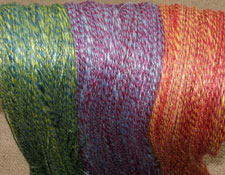
As usual, the proof is in the yarn. In these skeins (right), the aubergine/blue yarn in the middle was spun and plied with the newly revised electric spinner. Of the other two, the marigold/garnet yarn was spun and plied on a wheel, and the green was spun (slowly) on the old-motor electric spinner, then plied on the wheel.
All three are experimental yarns, testing equipment limits -- and it turns out this batch of silk is pretty good testing material: it's low-sheen and looks disappointingly matte (almost woolly) when the yarn doesn't have the optimal amount of twist.
These three worked, though. They all have enough twist to maximize the gentle sheen -- and they have the tussah sparkle that I love.
Snow!! ...Snow in April!!
This was not on the weather map for this morning.
That said, the weather has been all over the map for the past day or so. In the wake of sun, wind, rain, sleet, and hail, snow shouldn't be all that surprising.
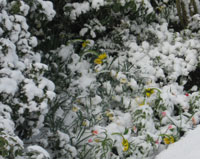
But it is.
If this were a region that spent large parts of winter covered in snow, the sight of that cold white stuff probably wouldn't inspire this feeling of excitement and joy -- but this is a temperate zone, and the joy is real. Snow!! It's magical!
One of the amazing things about this small amount of snow (it's just a few inches deep and probably won't last through the day) is that instead of covering all colour, it puts it into relief. The new blossoms on the potted lavender (top photo) show an even more vivid purple than normal, and the chives in the neighbouring pot are a vibrant, rich green.
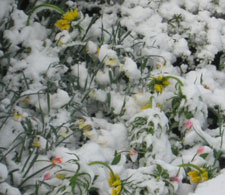
It's as though the snow has arrived for one precise reason: to demonstrate that the tender new blossoms of spring are miraculous in their own right, and to draw our eyes to their colours by masking off everything that might distract us from really seeing them.
I swear, the daffodils and tulips in this flowerbed (left) did not have such rich yellows and pinks just 24 hours ago.
Click on the small photo to better see the effect.
The last time I checked in here, the world outside my window looked like this (left). Spring was doing its best to erupt, but late-winter storms were still cruising through to show us all who's boss.
Since then, much has changed. I've been out of town: the "Stitch and Craft" show in London lured me from my den to join my Braidmakers' Workshop friends for four full days of braiding, teaching, talking, and listening. It was fun! There are a lot of nice people in the world.
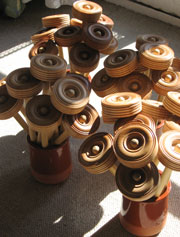
Before I could go, though, I needed to prepare spindles and fibre for my silk-spinning workshops (right). I was once again teaching the "Silk and Spindle" workshop (four times in four days), so there needed to be 40 smooth, balanced spindles and 40 class-kit packets of silk -- plus a few spares of each, just in case.
The dyepot simmered, sandpaper rasped, the apartment swirled with pungent smells of vinegar, Danish oil, paste wax and clean wood. Yarns hopped in their baskets and skipped across the floor as I made warps for braiding kits. The printer hummed in the office, printing instructions and supply lists -- and occasionally crying out cheerfully, "More paper! More ink!!"
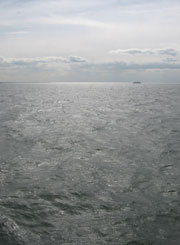
The day at last arrived, and I left. In past years I've taken a (relatively) cheap flight to London, then caught a ride to the show from there (thank you, Shirley!). This time around I learned that the ferry between Calais and Dover can be truly inexpensive, if you buy your ticket far enough in advance. So I did!
It's risky business to cross the Channel early in the year -- not because of any real danger, but because some of us are not exactly Nature's sailors. :-/ ...Clement winds were with us, though: the weather was calm and the water, smooth.

For those who haven't seen them -- the famous cliffs of Dover really are white (right). Coming into England from France or Holland, it makes quite a striking arrival point. I imagine early air travellers in the 1930s flying into England from the Continent seeing those amazing chalky cliffs out their windows and feeling a warm flash of "coming home!"
My warm flash on arrival was a little different -- I shared it with Italian truck drivers who'd also made the crossing, all of us driving gingerly through the town of Dover on the unnatural side of the road. (It's unnerving at first, but as long as everyone's doing it, it works out!)
The four days of the show were a blur of happy activity. We'd been told the show was mainly for cardmakers and scrapbookers, with some embroidery on the side. It was actually more than that, with tempting offerings for all interests. Paper-working materials were in an upstairs vendor hall; threads, patterns, notions, beads and Things Textile were in the hall on the ground floor. And there were some grand things! Our booth was busy most of the time, so I didn't get around to shop much... which is probably just as well. ;-)
It was a great week. My spinning students were enthusiastic and lovely (a couple have been in touch since -- I have new friends!). Every single one of them was making beautiful silk yarn by the end of the class time. :-) My camera stayed in the bag, so we have no photos; but my mind is still full of the faces and voices of the wonderful people we met.
After the show, my friend Shirley and I had planned to do touristy things -- but instead we were drawn to less energetic pursuits (feet up, kettle on, chill out). ...We did manage to buzz down the road to Fibrecrafts, where we spent an entire afternoon (!) blissfully perusing books, fondling fibres, testing wheels.... We browsed and dawdled. It was a real treat. (It also nicely took care of any small change we had in our pockets after the show -- as you might imagine!)
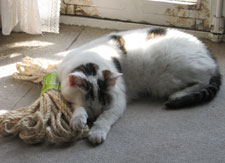
My old beater car and I made it back home before the next late-winter storm arrived -- though there were a few tense moments in the last hour of driving when a rather nasty vibration started in the right front wheel. It wasn't dangerous, apparently -- but it was unsettling. (And yes, since then it's been repaired.)
We rolled into our parking space just in time for dinner. I got that rush of the "coming home!" feeling at the sight of our resident Furry Heartwarmer (left) -- and I'd barely set down my bags when my husband offered me a lovely glass of Bordeaux.
The roof leaks, the carpet's stained, there's a crack in the bathroom window -- but it's really true: there's no place like home!
End notes, for inquiring minds
♦ The Braidmakers' Workshop gets together for shows to share the excitement and joy of braiding. If you see something pretty in our booth, we'll teach you how to make it! Click here for more information.
♦ The "Stitch and Craft" show is one of several shows where you can find us in and around the U.K. Click here for information on show schedules.
Colour inspirations sometimes come in unexpected places.
We'd had these beautiful potatoes with dinner the night before, and the next morning I was cutting them up for potato salad -- and my, they were pretty! It's one thing to eat richly tinted potatoes (steamed and whole) for dinner, but quite another to see their glory unveiled in the full-spectrum light of day.
These are called "blue" potatoes in North America. Here in France they're referred to by their varietal name: Violetta.
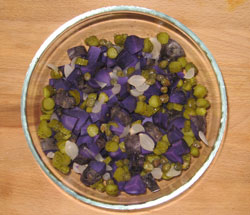
The photos give a hint, but they really don't do the colour justice. It's a particularly luminous shade, hovering between blue and purple, set off to perfection by the black potato skins.
It made me want to capture the colour in my mind's eye and recreate it on silk in my dyepots. Alas, it may be too elusive for that!
This is beauty to be appreciated in the fleeting, delicious moment.
15 March 2008
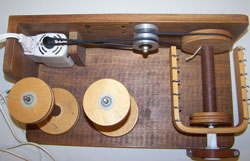
Sometimes when strolling the echoing halls of eBay, you'll find something you need. This is a case in point: for some time I'd been wanting to get an electric spinner (wired for European voltage) -- and there it was, just waiting for me!
This is a Louet electric spinner (model S30, no longer made). It was manufactured in 1979, which makes it about the same age as my Louet spinning wheel.
Its birthdate implies a number of things about the way it operates and the kind of yarn it spins (details to be revealed, just keep reading) -- but it also means that if I open the closet, all the spare bobbins and flyers in the box marked "Louet" will work on this machine. (Some selling points really make a thing irresistible!)
As soon as it arrived, I unpacked it, oiled it, and set to work.
Spinning is spinning, no matter what the tool -- and this Louet spinner has the same feel as other Louet wheels from the the late 1970s. Being one who learned to spin around that time, and whose first wheel was a Louet with all that that meant, I know how to work around the things I don't like....
The early Louets tended to pull very hard on the yarn as you were spinning. That's wonderful if you're spinning wool in the grease (or even clean wool that you want to end up as a lofty yarn) -- but for silk and other fine fibres it's not so great.
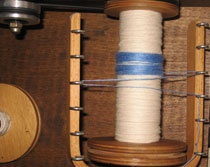
Three things help when spinning finer fibres on an early Louet:
(1) speed,
(2) a fatter bobbin core, and
(3) criss-crossing the yarns between the flyer hooks.
Speed is easy to adjust, and criss-crossing is a piece of cake; all I needed was a fat core on the bobbin. Stubbornly intent on using the original bobbins (rather than the fat-cores I already own), I rounded up some scrap cotton string and wound it onto the bobbin's core to plump it up. ...Darned if it doesn't work perfectly! :-)
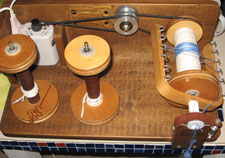
The first two skeins are fuzzier than I'd wanted, which puzzles me because the yarn seemed firm and well-twisted while I was spinning. More speed could fix the problem, and I'll make adjustments to that end (a new O-ring to drive faster bobbins, and if that's not enough, a new motor). ...In addition, I noticed telltale wear on the flyer: a groove worn in the orifice, some grime, and roughness on half the hooks (the former owner apparently spun greasy fleece and used only one of the flyer arms). The groove and rough hooks may be abrading my silk yarns as they pass.
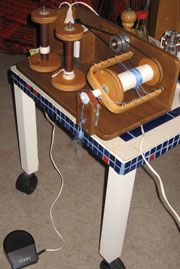
But here's the bottom line: even though my first two skeins are not yet the quality I want, their production time was super! It had been taking me a whole evening to produce one skein of this particular yarn (40g of silk, spin each ply, ply them together, then wind the skein). The first sample skein spun on this spinner took just two hours, start to finish. The second skein (spun with the controller "pedal to the metal") took just one and a half hours.
And that puts us into the ballpark for production spinning. :-)
Post Script.
I was trying to solve the "fuzzy" problem this afternoon by changing drafting technique and using a different flyer (I know, it's not good scientific method to change two variables at the same time).
Using the short-draft "inchworm" technique rather than supported long draw, I get a singles that's more firmly twisted (the short-draft technique is slower, so there's more time for twist to go into the yarn). The singles is also sleeker (a direct result of the drafting technique).
The fuzziness wouldn't bother me at all if I were spinning wool; but it's not what I want for these silk yarns.
It's a fun puzzle! Stay tuned, I'm certain there's more to come....
Oooooo, our aching joints!
A series of March storms has been slashing through the region this past week, flinging unwarranted amounts of rain against the windows and straining the branches of trees outside.
Her Highness soothes her stiffness by lounging on the heating pad with a friend (right). ...I take a different approach.
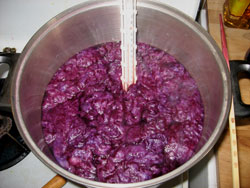
When the skies get dark and stormy, fight back with lots of colour!
This one (left) is a new blend for me, and to my astonishment it seems to go beautifully with every dyed colour in my little sample book! That's an unexpected reward. ...Of course I'm planning tons of marled yarns with this as one of the colours, so I'll have to dye many more batches of silk -- but hey, the weather's right for it, so why fight it?
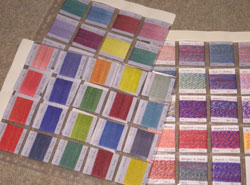
Toward the end of last fall's intensive dyeing sessions, my old notebook of dye records was clearly not up to the task. It's great for notes of the exact methods used with different dyes, or experiments and their results; but it's really not very good for keeping track of colours. I mean, two months after the fact, it's hard to remember just what I'd meant by "Medium greeny blue".
The new method uses plastic notebook sheets intended for photographic slides. Each little insert is wrapped with singles yarn spun from the fibre from a particular dyebatch, with the depth of shade and dye-mix formula written on top.
It's saved a lot of time already! And that's grand. :-)
The inkle loom received a new warp this past week (another step forward in decluttering): handspun, hand-dyed Tencel. This large and special skein was spun from a top that I'd space-dyed, so its variegations are beautifully irregular. The skein has been patiently waiting several years to meet its destiny -- and here it is: a series of inkle-woven bands, which will eventually become a vest (or part of a jacket, it's not clear). There are more than 600 yards of this 2-ply yarn, so that should produce a nice woven length to work with. :-)
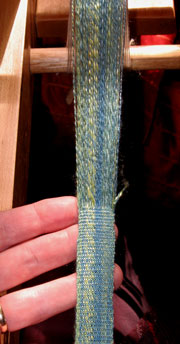
It's worth mentioning here for two reasons. First, narrow weavings are a wonderful way to showcase special handspun yarns. Inkle bands, backstrap-woven bands, tablet-woven bands, and bands woven on a rigid heddle are warp-faced, which means the yarns used in the warp are the only ones that show -- and they show very well, resting shoulder-to-shoulder on both front and back sides of the weaving.
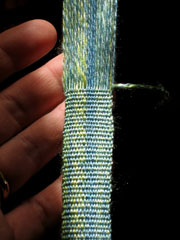 Second -- I was rambling on about marled yarns the other day, and this band demonstrates how a marled yarn can gently shift the appearance of a weaving. If you examine the close-up photos of this band (click on them for a larger view), you can see the yarn in the yellow-toned area actually has one ply of yellow and the other of sea-green. In the yarn, it has a faint "barber-pole" look to it -- but the weaving benefits in a lively and unexpected way.
Second -- I was rambling on about marled yarns the other day, and this band demonstrates how a marled yarn can gently shift the appearance of a weaving. If you examine the close-up photos of this band (click on them for a larger view), you can see the yarn in the yellow-toned area actually has one ply of yellow and the other of sea-green. In the yarn, it has a faint "barber-pole" look to it -- but the weaving benefits in a lively and unexpected way.
Isn't that enchanting??
As an end note, the inkle loom you see in these pictures is very special to me. My father and I built it together in his basement in January 2006 -- we made one for him and one for me. It's made of maple, is equipped with hardwood pegs, and pretty precisely matches the diagram in Helene Bress' book, Inkle Weaving.
Tool-making can be a joy. There's a special pleasure that comes from working on equipment you've made with your own hands. That pleasure is deepened and enriched when the making of that equipment was shared with someone you love. Thanks, Dad!
We may be on the edge of March, but we're not done with winter yet! When the light is bright and lovely, though, that's not a problem. The colours are pastel, all surfaces sparkle with crystalline reflections -- it's cold, but everything seems filled with light.
Cold, with bright light -- it's excellent weather
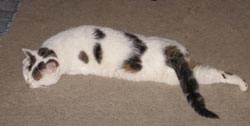 for spinning, for sorting through fibre, and for quiet contemplation.
for spinning, for sorting through fibre, and for quiet contemplation.
Some may find this weather best for lounging...
... but the rest of us are caught up by the whirl of flyers and the contemplation of twist as it enters the magical drafting zone. Twisting. Fibres gliding. Twist and glide. And glide. Drafting. Turning. Thoughts of the past. Breathing. Dreams. There's one smooth motion, one unending cycle.
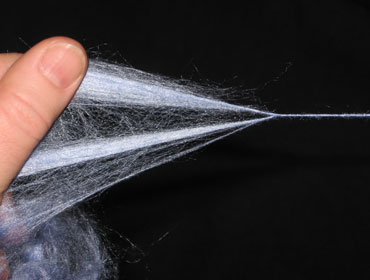
It's mesmerizing.
We spin and think.
We drift and draft.
We tune in.
We zone out.
26 February 2008
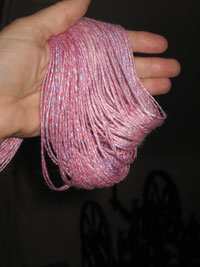
We've been spinning lots of silk lately, the cat and I. An acquaintance has a yarn shop and has been looking for something exotic and unusual -- and as it happens I've been looking for some pocket money. We might be able to work something out.
The silk is tussah, dyed in undulating colours in my dyepot. I'm spinning skeins of two-ply yarn: each ply is a different colour, chosen to show off its partner to best advantage.
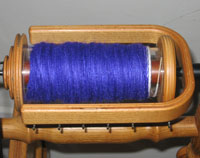
Even colours like vivid imperial purple (right) shift and seem to change when paired with another shade. (They also shift when their photo is taken and they appear online; in real life this yarn is intensely purple, not blue!)
Plied with a rosy pink, this purple shows itself as a strong, vibrant force. Paired with poppy red, it becomes a spunky, purply source of energy. Married with a variegated yarn in berry shades, it shimmers from violet to rosy purple with sparkling glints of dark and light.
More subtle but equally interesting, a strong medium blue combines with a dusty burgundy -- and the result softens both shades and yields a lovely, harmonious yarn. ...A gentle rose mixes with lilac to produce a yarn that is neither pink nor lavender, but glows with its own fresh light.
These are known as "marled" yarns, these yarns of two colours plied together. Marled yarns have a long history in the knitting and weaving traditions of many European cultures, and they've historically blended two yarns of high contrast. You can find them in speckled black-and-white sweaters from Scandinavia, as surprising accent stripes in woven plaids, as flickery two-coloured stripes in rugs.
Knitted, the yarns make a fabric in which both colours play a role, but neither dominates. The effect is speckly in stockinette stitch. Garter stitch shows both colours more clearly and puts the focus on the yarns, revealing their sheen and beauty.
But they can also be woven. In plainweave, the two colours play hide-and-seek, giving a subtle iridescence to the cloth. The game is different in twill: viewed from a distance, the colours blend; but they dance in jazzy movement seen up close.
One simple source yields many effects. :-)
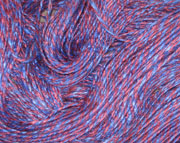
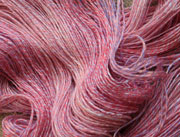


End notes, for inquiring minds
♦ The silk yarns shown above were all spun from tussah silk tops lovingly dyed in my dyepots. These silk fibres are available for purchase, packed in duos of colour and ready to spin -- at a very reasonable price. Click here for more information, or simply follow the "Products" link in the left column.
♦ The wheel shown in the photo of the purple silk singles is my faithful, never-say-die Louet, shown elsewhere in these pages.
22 February 2008

There are messages in the evening sky, if only we pay attention.
As the sun was setting, its last light splashed onto several com trails -- and it was so strikingly unusual that it needed recording. The streaks of frozen vapour blazed a brilliant orange, boldly standing out from the understated background of winter sunset.
This photo was snapped just moments after the blazing instant that had caught my eye, and already the effect was fading.
The messages are vivid and clear, but gone in the blink of an eye.
15 February 2008
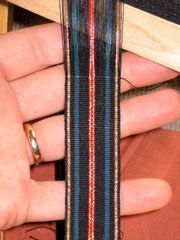
Inka dinka doo... a dinka dee... a dinka doo.
The inkle loom resurfaced a couple of days ago, complete with a weaving-in-progress. This warp was a very special one: silk sewing thread, with a few gold thread accents. The warp contains 151 ends, and the total width of the woven band is a little less than an inch.
That's a lot of fine thread all in one place.
The warping process (oh, so long ago!) took longer than inkle warping usually takes, and I remember thinking This is going to take absolutely forever to weave -- but the weaving actually went quite quickly. It took only about five minutes to weave each inch.
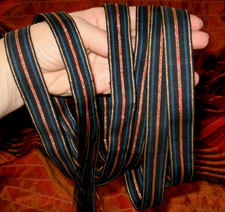
These silk threads are an absolute dream to work with! The weft slides almost effortlessly into place and packs easily into position; and each new shed opens with no grumbling or sticky threads.
It took ages to finish only because of that sap-sucking force that bogs down so many other projects: interruption.
Still -- there's a beautiful, magically lightweight silk band here now, cut free from its loom and ready to be used. The photo at right shows it before its ceremonial washing. It's now smooth, wrinkle-free, and deliciously supple.
In its corner, the inkle loom stands naked and shivering, begging for something new....
Stay tuned. I have a feeling things are gonna keep rolling. ;-)
12 February 2008
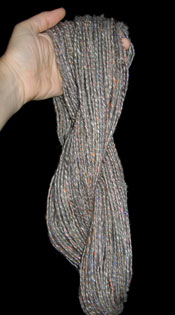
Decluttering and spinning go fairly well together. It's not without danger ("orphan" fibres can migrate from one part of the room to another, bypassing all good intentions and shifting the clutter without reducing it) -- but with steady attention, it works!
This new grey stuff is the latest to emerge from the process (left). The dominant fibre is an organic Shetland wool from Wales -- lovely, lofty, and carrying a faint hint of lilac in its shadows.
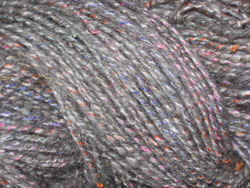
In plying, I combined the orphan wool with a couple of orphan skeins: a very fine 2-ply silk spun from hankies, and a fine textured thread with pastel variegations. (Click on the photo at right for a close view.)
The resulting yarn has a lovely hand: dense, supple, warm, and elastic. It has the colours of a pre-dawn sky. The silk adds the tiniest touch of lustre to the blend, and the natural shift of shades in the grey keeps everything lively.
I think I'm in love. :-)
08 February 2008

The days are getting longer. Spring is still many weeks away, but there are already stirrings -- and I've got the urge to declutter.
This is a recurring theme at our place, decluttering. It never arrives at any identifiable "end" point -- partly (I suspect) because the process is never-ending, and partly because halfway through sorting I'll drift away to something infinitely more interesting.
This time we're trying a new approach: each time I find an "orphan" baggie of fibre, I'm allowed to turn it into yarn.
This approach builds the natural distractions right into the decluttering process -- so there's not only a reward for unearthing a bag of unidentified fluff, but the act of transforming it into yarn is now vital to the programme: it keeps things moving in the desired direction.
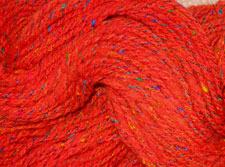
This red stuff is a case in point. It was originally "free" wool with a yellow stain in it -- completely unattractive until it had spent an afternoon in the dyepot.
The dyed red was so beautiful that I'd wanted to spin it immediately (way-back-when). I'd even carded the stuff into rolags, planning to take advantage of the wool's springiness by spinning it into a nice woollen yarn. ...That's quite a thing to unearth during a cleaning session: a basket full of ready-to-go rolags! How could anyone resist??
I added a fine, textured thread in the plying, carrying it along with the other two strands to make, in effect, a 3-ply yarn. (Click on the detail photo above for a larger view.) The variegations of colour in that fine, dark thread really make the red sing...
...and my heart sings along with it!
There's just enough yarn here for a scarf. I think it's mine.
30 January 2008
The voyage from one time zone to another happens quickly -- but we mere mortals take a while to adjust. One short week ago I was in a time zone nine hours different from the one I'm in now; and I still find myself wide awake in the wee hours of night, or irresistably (embarrassingly) dozing off at inopportune times.

Sleeplessness breeds invention: I've been raiding my yarn stash and creating a nice assortment of super-chunky yarns (left).
The process is perfect for those 3 a.m. work sessions. Taking an assortment of three or four very different yarns in one hand and a relatively heavy spindle (55 grams) in the other, I add a significant amount of twist. When the spindle is full, I slide the cop of yarn onto a quill (anchoring the twisty end with cello tape), then do it again. When the second cop has been twisted up and placed on its quill, I take the two quill-fuls and ply them together.
It's a lot of fun, truth be told. :-) It's interesting to see how a yarn changes when plied with yarns unlike it -- yarns of another colour, structure, material, or form. The most satisfying results come from combining radically different yarns. Smooth becomes textured; matte surfaces take on a gleam.
I don't know what I'm going to do with this stuff -- but it's a grand process!
Let's cut straight to the chase, shall we?? ...The charkha-spun yarn seems to be working just fine in this ruffly-corkscrew knitting project!
The concept of this ruffly scarf is simple: cast on some stitches (I'm using 13), then knit a triangle by decreasing on alternate rows (thereby putting the decreases all along one edge of the triangle). When you're down to two stitches, pick up stitches all along the edge of the triangle to bring the total back to the original number (for me, 13), then do it again. And again. And again.
My knitting skills are basic, and I occasionally forget exactly which edge of the triangle I want to pick up stitches on (surely it will get more obvious as I go along -- right??); but this project isn't out of reach, even for someone like me.
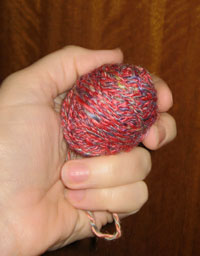
The thing most important to me right now, though, is that the yarn has really turned out well: the right size for my knitting skills, pleasantly shiny, and deliciously supple in the hand. In a word: silky.
These yarns are being plied on a spindle (yes, of course I have one with me!). The charkha is an excellent spinning tool, but it's not a lot of fun to use for plying -- the spindle's a much better tool for the job. It's nice that with a narrow knitting project like this, the small balls of yarn that come from a spindle are just the right size -- it feels like they're made for it, in fact. It's especially nice here because I'm using very short needles, the kind they sell for kids.
And guess what?? In the interest of minimalist packing, here's a bit of information that all travelling spinners should know: A highlighter pen makes a dandy nostepinne! ;-)
30 December 2007
Happy holidays....
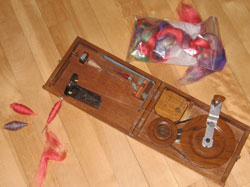
Like many other people, I'm visiting family over the holidays -- and as usual, the spinning supplies made their way into the suitcase. :-)
Usually the on-the-road supplies involve a bag of fibre, some small combs or cards, and a selection of spindles; but this time the charkha won out (left). It's such a nice wheel, compact and versatile -- and it perfectly suited the silk I'd been hungering to spin. ...Yes, silk. {Happy sigh} It spoke up and took centre stage: a length of variegated tussah top paired with a length of shimmering poppy-red. Who could resist??
Besides, there was a good excuse, er, reason for bringing the silk.
At one of the knitting shows last fall a scarf captured my attention. It was narrow and had been knit in such a way that it spiralled around itself in an attractive, ruffly corkscrew. As soon as I saw it, I imagined it in silk -- and that's the vision motivating this current effort.

Silk for knitting. That may not sound like much of a challenge, but in fact it is. Most of the charkha spinning I do is destined for weaving, and those yarns are usually quite fine, even after plying. This time I wanted them to be a little bit thicker -- the thickness would be nicer for my primitive knitting skills, and it would also show off the sheen of the fibre.
So I set to work, concentrating on letting more fibre get caught by the twist so I'd end up with knitting yarn rather than sewing thread. ...The result (right) is not too bad! (Click on the photo for a closer view.) Once these two cops have been plied together, the yarn will be pretty close to the hoped-for result. We'll see....
Two things are worth noting in the current charkha projects. First, there was only one empty spindle in the charkha box when I sat down to spin (partially-filled spindles abound, as usual!) -- and I wanted to spin several batches of yarn, then ply them, so that just wouldn't do. I decided to make little paper sleeves that closely fit the spindle, then spin onto (and ply off of) those. I've used quills before in spinning on the great wheel, but had never tried it with the charkha -- and it works like a charm!
Second, the fine drive band that runs between the accelerating wheel and the spindle broke after spinning just a few yards of yarn -- and of course that was the one spare part I hadn't brought with me. :-P
My mother's sewing box is in disarray these days and didn't contain any likely-looking threads, so my repair couldn't be made from that source -- but down in the basement, the box Dad uses for fishing tackle is still orderly.... To draw this story to a swift close, I'm happy to report that fishing line makes a darned good drive band! :-)
It's monofilament nylon, fine enough to solidly hold a knot, but thick enough to be visible to human eyes. So far, it's working beautifully. It makes a slight banjo-string sound during spinning, and the knot noisily goes "ka-lump" each time it passes around the spindle -- but it suits the function, and right now that's the most important thing!
Return to the Archive directory page
Return to the Now spinning page
